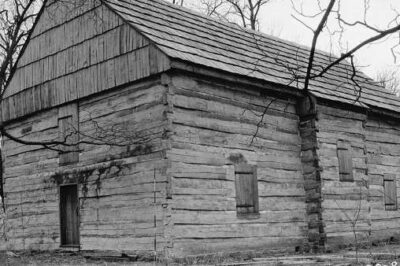Over 100 years before the Azusa Street Revival God invaded the frontier forests of Kentucky. God seemed to be everywhere. It was awful. Wait, I didn’t say it was “awesome.” No, it was awful, terrifying and scary for the atheists that visited here during the awakening.
For believers, this place had an awe-inspiring reverential wonder about it. In addition to the awareness of God, there was fiery gospel preaching that would cut men to the heart, awaken them to their need of Jesus, and lead them into a transformed life.
History would highlight a blending of prayer, presence, and powerful preaching at Cane Ridge. I’m actually writing this from a bench inside the prayer house made in 1829 positioned just behind the pulpit dedicated to Barton Stone, who was a leader in the awakening here. It was said that the preaching from this pulpit would go on for days and weeks at a time.
The desperate frontiersmen called this building, “A House of Prayer for all Nations.” I love that. The pioneers started with the only proven foundation in history for awakening: prayer. But the prayer culture in this area wasn’t the only thing that Cane Ridge was known for. This house of prayer would soon become a house of God’s Presence. There was a strange and unusual awareness of God that saturated the ground here like a Kentucky spring rain. God’s weighty presence is here.
I came here today to dream. I’m dreaming of whole communities encountering and sustaining the glory of God. I want that awareness of God’s Presence that lingered here, their sense of wonder. I’m asking the Lord for an impartation, a resolve to see an awakening in my day created in a culture of prayer, with a primary pursuit of seeking God’s Presence, and power on the preaching of the gospel like they had here.
Cane Ridge was no hype. It was a pioneer’s awakening, with pioneer grit, pioneer desperation, and pioneer manifestations. Imagine cutting your way through the forest and being halted in your tracks by distant shouts and screams coming up over the next hill. Then the sound changes to the thunderous preaching of a man doing his best to be heard over the noise of the crowd. He has no microphone, no speakers, no lights, or media. Everything was completely uncomfortable to the seeker and every word born from a burning House of Prayer.
I Wish I Had Stayed Home
In 1801, an atheist named James B. Finley, visited the Cane Ridge awakening in Kentucky. James said, “The noise was like the roar of Niagara. The vast sea of human beings seemed to be agitated as if by a storm … Some of the people were singing, others praying, some crying for mercy in the most piteous accents, while others were shouting vociferously. While witnessing these scenes, a peculiarly strange sensation, such as I had never felt before, came over me. My heart beat tumultuously, my knees trembled, my lip quivered, and I felt as though I must fall to the ground. A strange supernatural power seemed to pervade the entire mass of mind there collected. At one time I saw at least 500, swept down in a moment as if a battery of a thousand guns had been opened upon them, and then immediately followed shrieks and shouts that rent the very heavens. I fled for the woods and wished I had stayed at home.”
Dream with me of an awakening in our day so wonderfully awful that the postmodern atheist acknowledges the sheer fierceness of God’s nearness. The atheist, James B. Finley wishes he’d stayed home from Cane Ridge meetings because the presence of God he felt here was so real, why do they stay home from our meetings today?
They reported that people shook and lips quivered as others fell to the ground with loud shrieks and shouts. Peter Cartwright was one of the prominent preachers in Cane Ridge. He called the manifestations “the jerks” and said that they seized saints and sinners with convulsive jerking all over, which they could not avoid, and the more they resisted the more they jerked.
Awakening Unto Reformation
The Second Great Awakening (1780-1810) in America was considered great not just because of what it did for the church, but how it transformed culture. It greatly influenced the abolition of slavery, the end of child labor, prompted a move towards literacy for everyone, and called for prison reform.
Cane Ridge was so much more than emotional manifestations. It greatly impacted all of society around it. There you have it. What is still the only requirement for a healed society? The glory of God. The only remedy is still, “If my people who are called by my name will humble themselves, and pray and seek My face, and turn from their wicked ways, then I will hear from heaven, and will forgive their sin and heal their land” (2 Chronicles 7:14).
We don’t do it because it’s simple. We don’t do it because we have unbelief about prayer. What if we did? Stay tuned for part two of this article.
Join Jennifer LeClaire and Ryan LeStrange to make an appeal to heaven at the historic Cane Ridge meeting house this summer.Click here to register.
Pockets of true revival are breaking out across America. Want to know more about the next great move of God? Click here to see Jennifer LeClaire’s new book, featuring Dutch Sheets, Reinhard Bonnke, Jonathan Cahn, Billy Graham and others.
Matt Pettry is on the senior leadership team of The Place. He has been teaching at the college level for seven years. He enjoys keeping a pulse on the signs of the times and sharing the lifelong value of devotion to Jesus. He passionately trumpets a call to awakening and reformation through gospel preaching, intercession, and through biblical strategies for the in-breaking of God’s government. Visit him online at MattPettry.com.







Leave a Comment
You must be logged in to post a comment.